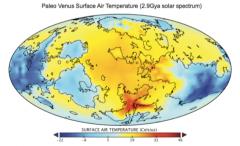Was Venus the first habitable world of our solar system?

- Paleo Venus Surface Air Temperature (2.9 Gya solar spectrum)

- © Way et al., Geophys. Res. Lett. 43, 8376 (2016)
Dr. Michael Way
(NASA Goddard Institute for Space Studies, New York)
Freitag/Friday, 2017-03-24 14:00 c.t., EW 114
Eugene-Paul-Wigner Gebäude, Hardenbergstr. 36, 10623 Berlin
Zusammenfassung/Abstract:
A great deal of effort in the search for life off-Earth in the past 20+ years has focused on Mars via a plethora of space and ground based missions. While there is good evidence that surface liquid water existed on Mars in substantial quantities, it is not clear how long such water existed. Most studies point to this water existing billions of years ago.
However, those familiar with the Faint Young Sun hypothesis for Earth will quickly realize that this problem is even more pronounced for Mars. In this context recent simulations have been completed with the Goddard Institute for Space Studies 3-D General Circulation Model of paleo Venus at 3 billion and 715 million years ago (the latter is around the time of the great resurfacing event) when the sun was less luminous than today. We use this and other information to provide modern Venus an ocean of average depth 310 m and an atmosphere similar to present day Earth. A combination of a less luminous Sun and a slow rotation rate reveal that Venus could have had conditions on its surface amenable to surface liquid water in its early history. It is possible that less assumptions have to be made to make Venus an early habitable world than have to be made for Mars or Earth, even though Venus is a much tougher world on which to confirm this hypothesis.

